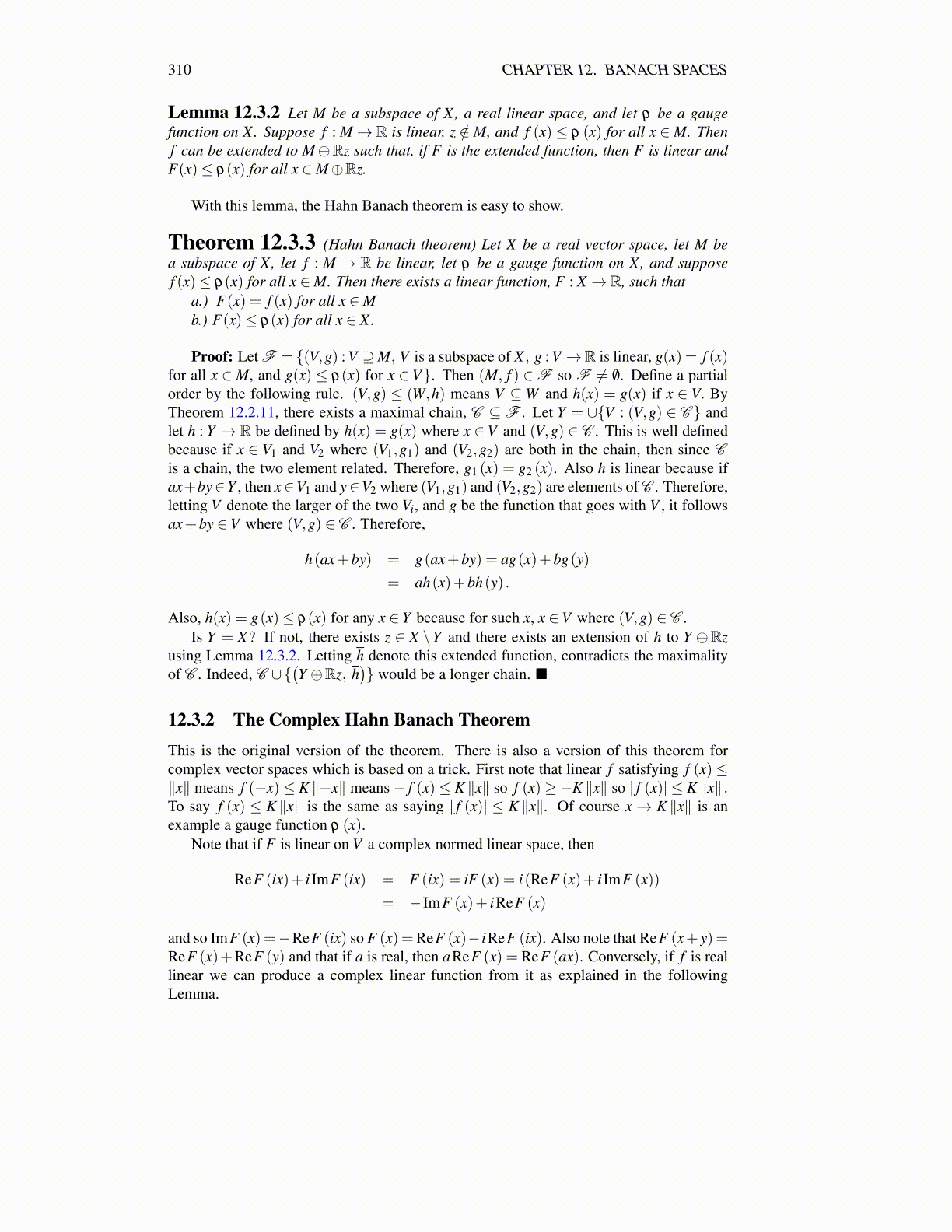
310 CHAPTER 12. BANACH SPACES
Lemma 12.3.2 Let M be a subspace of X, a real linear space, and let ρ be a gaugefunction on X. Suppose f : M→ R is linear, z /∈M, and f (x) ≤ ρ (x) for all x ∈M. Thenf can be extended to M⊕Rz such that, if F is the extended function, then F is linear andF(x)≤ ρ(x) for all x ∈M⊕Rz.
With this lemma, the Hahn Banach theorem is easy to show.
Theorem 12.3.3 (Hahn Banach theorem) Let X be a real vector space, let M bea subspace of X, let f : M → R be linear, let ρ be a gauge function on X, and supposef (x)≤ ρ(x) for all x ∈M. Then there exists a linear function, F : X → R, such that
a.) F(x) = f (x) for all x ∈Mb.) F(x)≤ ρ(x) for all x ∈ X.
Proof: Let F = {(V,g) : V ⊇M, V is a subspace of X , g : V →R is linear, g(x) = f (x)for all x ∈M, and g(x) ≤ ρ(x) for x ∈ V}. Then (M, f ) ∈F so F ̸= /0. Define a partialorder by the following rule. (V,g) ≤ (W,h) means V ⊆W and h(x) = g(x) if x ∈ V. ByTheorem 12.2.11, there exists a maximal chain, C ⊆ F . Let Y = ∪{V : (V,g) ∈ C } andlet h : Y → R be defined by h(x) = g(x) where x ∈ V and (V,g) ∈ C . This is well definedbecause if x ∈ V1 and V2 where (V1,g1) and (V2,g2) are both in the chain, then since Cis a chain, the two element related. Therefore, g1 (x) = g2 (x). Also h is linear because ifax+by∈Y , then x∈V1 and y∈V2 where (V1,g1) and (V2,g2) are elements of C . Therefore,letting V denote the larger of the two Vi, and g be the function that goes with V , it followsax+by ∈V where (V,g) ∈ C . Therefore,
h(ax+by) = g(ax+by) = ag(x)+bg(y)
= ah(x)+bh(y) .
Also, h(x) = g(x)≤ ρ(x) for any x ∈ Y because for such x, x ∈V where (V,g) ∈ C .Is Y = X? If not, there exists z ∈ X \Y and there exists an extension of h to Y ⊕Rz
using Lemma 12.3.2. Letting h denote this extended function, contradicts the maximalityof C . Indeed, C ∪{
(Y ⊕Rz, h
)} would be a longer chain. ■
12.3.2 The Complex Hahn Banach TheoremThis is the original version of the theorem. There is also a version of this theorem forcomplex vector spaces which is based on a trick. First note that linear f satisfying f (x)≤∥x∥ means f (−x)≤ K ∥−x∥ means − f (x)≤ K ∥x∥ so f (x)≥−K ∥x∥ so | f (x)| ≤ K ∥x∥ .To say f (x) ≤ K ∥x∥ is the same as saying | f (x)| ≤ K ∥x∥. Of course x→ K ∥x∥ is anexample a gauge function ρ (x).
Note that if F is linear on V a complex normed linear space, then
ReF (ix)+ i ImF (ix) = F (ix) = iF (x) = i(ReF (x)+ i ImF (x))
= − ImF (x)+ iReF (x)
and so ImF (x) =−ReF (ix) so F (x) =ReF (x)− iReF (ix). Also note that ReF (x+ y) =ReF (x)+ReF (y) and that if a is real, then aReF (x) = ReF (ax). Conversely, if f is reallinear we can produce a complex linear function from it as explained in the followingLemma.